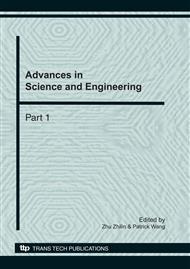[1]
Jun Xiao, Jingchun Duan, Hua Wang, et al.: Utilization of biomass. J. In: Safety and Environmental Engineering, Vol. 10, No. 1, 2003, pp: 11-14.
Google Scholar
[2]
Jing Xu: Study of alkali metal deposition during biomass combustion. D. In: Zhejiang University, (2006).
Google Scholar
[3]
Xiaoqin Ma, Zhongyang Luo, Mengxiang Fang, et al.: Additives effect on behavior of alkali metals to straw combustion process. J. In: Zhejiang University, Vol. 40, No. 4, 2006, pp.599-604.
Google Scholar
[4]
Xiaoqin Ma: The study progress of alkali metals problem during straw combustion. J. In: Water Resources and Electric Power Machinery, Vol. 28, No. 12, 2006, pp.28-34.
Google Scholar
[5]
TRANKhanh-Quang, IISA Kristiina, STEENARI Britt-Marie, et al.: A kinetic study of gaseous alkali capture by kaolin in the fixed bed reactor equipped with analkali detector. J. In: Fuel, Vol. 84, 2005, pp.169-175.
DOI: 10.1016/j.fuel.2004.08.019
Google Scholar
[6]
Chunjiang Yu, Zhongyang Luo, Wennan Zhang, et al.: The transformation of precipitation of alkali metals and related inorganic elements in biomass pyrolysis. J. In: Fuel Chemistry and Technology, Vol. 28, No. 5, 2000, pp.420-425.
Google Scholar
[7]
Baxter, L. L., Miles, T. R., Miles, T. R., Jenkins, ect.: The behavior of inorganic material in biomass-fired power boilers: field and laboratory experiences. In: Fuel Process Technol., Vol. 54, 2002, p.47–78.
DOI: 10.1016/s0378-3820(97)00060-x
Google Scholar
[8]
U. Gottwald, P. Monkhouse, B. Bonn: In: Fuel, 80(2001) 1893.
Google Scholar
[9]
Aho, M. and Ferrer, E.: Preventing chlorine deposition on heat transfer surfaces with aluminium-silicon rich biomass residue and additives. In: Fuel, Vol. 83, 2004, pp.1299-1305.
DOI: 10.1016/j.fuel.2004.01.011
Google Scholar
[10]
Nielsen H P, Baxter L L, Sclippab G, etal.: Deposition ofpotassium salts on heat transfer surfaces instraw-fired boilers: a pilot-scale study. J. In: Fuel, Vol. 79, 2000, pp.131-139.
DOI: 10.1016/s0016-2361(99)00090-3
Google Scholar


